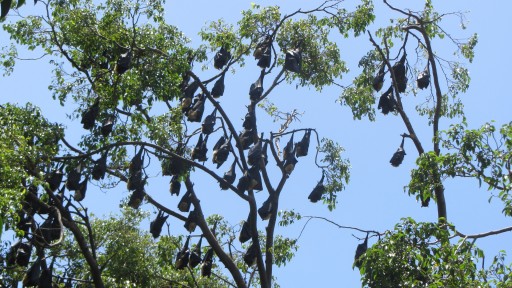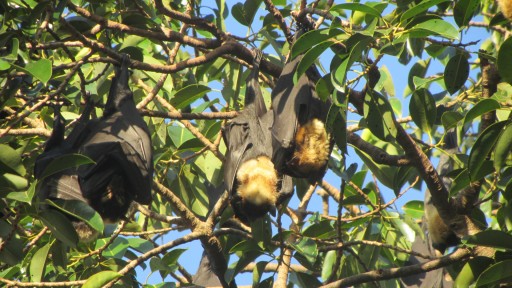Cairns Council vs Flying Foxes
During my three-week stay in Cairns last year, I was delighted to discover a populous colony of Spectacled flying foxes (Pteropus conspicillatus) roosting on the trees right in the middle of the city. These enormous fruit-eating bats, reportedly numbering between 10 and 20 thousand individuals, had made their homes on several large mango trees that grow between the city’s public library and the nearby Novotel resort. Although generally quiet during the day, they become very active at dusk, turning the Cairns central business district into an incredibly noisy area where thousands of crying animals would fly over the passer-bys’ heads, cars and buildings. One could easily imagine being in the middle of a tropical rainforest instead of a fairly large Australian town!
Sadly, last week the Cairns Regional Council decided to remove the flying foxes from the city centre. It was a close vote (five for and four against) and, since the animal concerned is a protected species, the outcome is still subject to approval by Australia’s federal government. As expected, this is a contentious issue and the controversial decision has stirred a heated debate among the residents of the city. Yes, the bats make noise and dirt. Yes, they can be a health risk. And yes, they do give extra headaches and increased expenses to the businesses in the area. But are these reasons sufficient for such a drastic interference with the natural environment?
As a visitor, I was extremely pleased to be able to observe the bats so closely – where else in the world can one experience anything similar? If I were a resident, I would be proud of the unusual oasis of natural environment right in the middle of my town. And even if I were a general manager of a large hotel, I’d probably try to turn the flying fox colony into the establishment’s advantage instead of seeking every opportunity to get rid of the flying mammals. In the end economic interests of big businesses won – despite the research and opinions of natural scientists and environmentalists who were mostly against the forceful move.
But all is not lost. According to an earlier article in Cairns Post, the bats might still end up winning the battle. Researchers who studied other attempts at relocating large colonies of flying foxes found that seven out of ten attempts had failed, with the bats eventually returning to the original roost or an area nearby. And how do you disperse thousands of bats from an established home? One curious technique is using loud heavy metal music just before dawn when the nocturnal animals return to settle down on their trees for a good day’s rest. This needs to be repeated on a daily basis for several weeks, even months, for the bats to definitely abandon the area.
Just imagine what it would be like staying in the nearby hotel during this time…
(This page has been viewed 795 times.)


One has to wonder about the combined foresight of the Cairns Regional Council. We now have an invasion of flying foxes in Palm Cove. People at Edmonton have also complained of having the beasties after 14 years of nothing. Does the Council have plans to move the flying foxes on again from our homes or are we the ones who wear the consequences of their ‘successful’ eradication.
Good one?????
Jeff
3/24/15: Well, I just got back from Australia after vacationing and the bats are still in Cairns, specifically in the tree on the Novotel property. It was so interesting seeing them swarm at dusk to fly off for the rain forest. I was so drawn into seeing them every night. But what I didn’t notice was many T shirts or other souvenirs in the Night Markets. As a resident, if I couldn’t get rid of them I would try to make a few bucks off of them. As a tourist, I would have bought a “I Love Cairns Bats” bumper sticker.